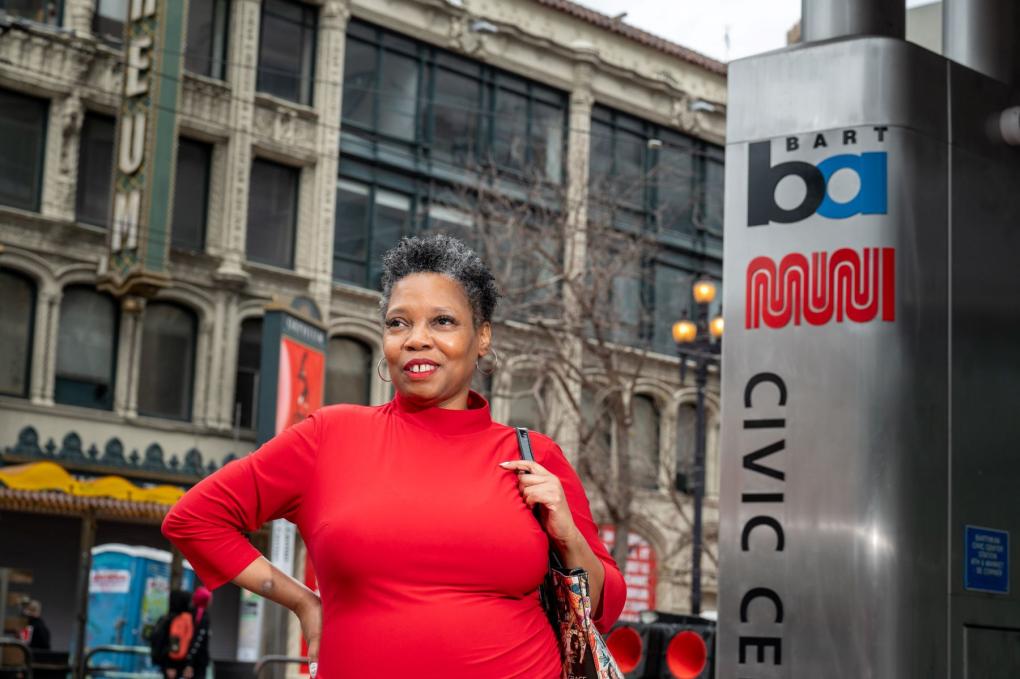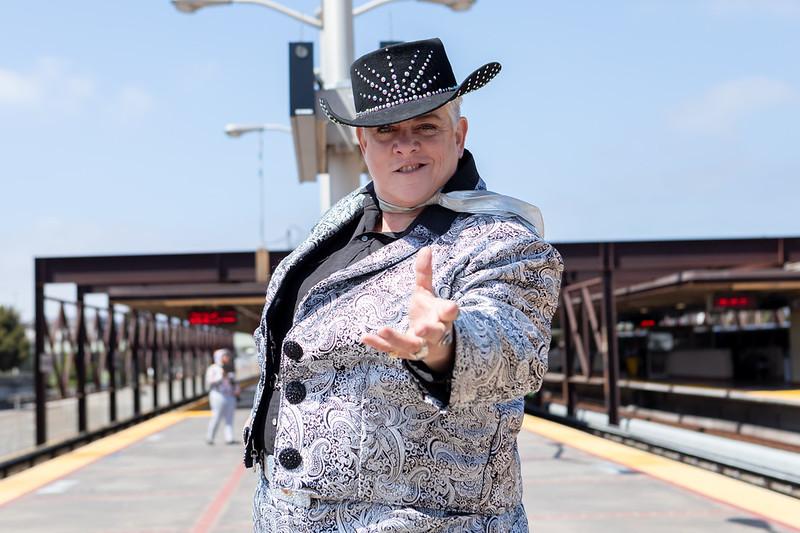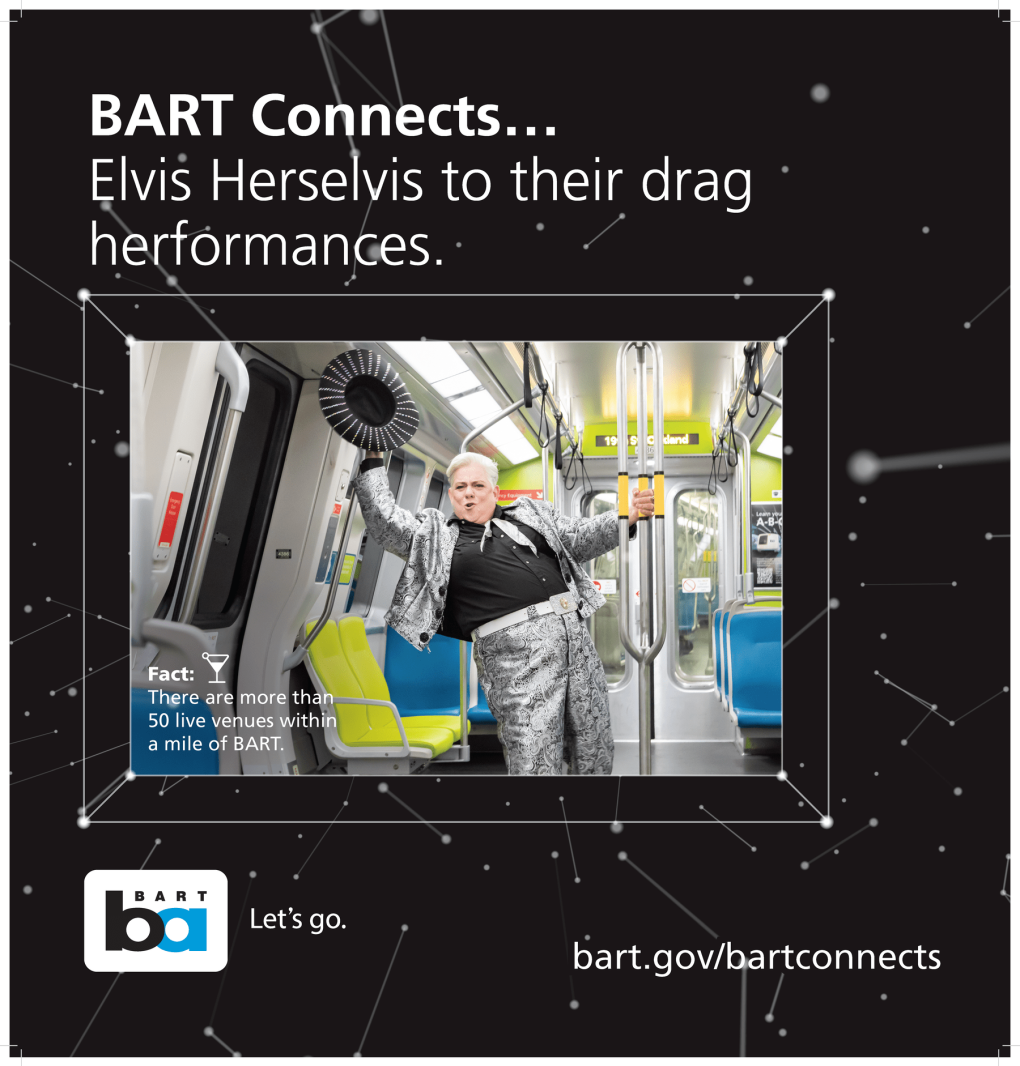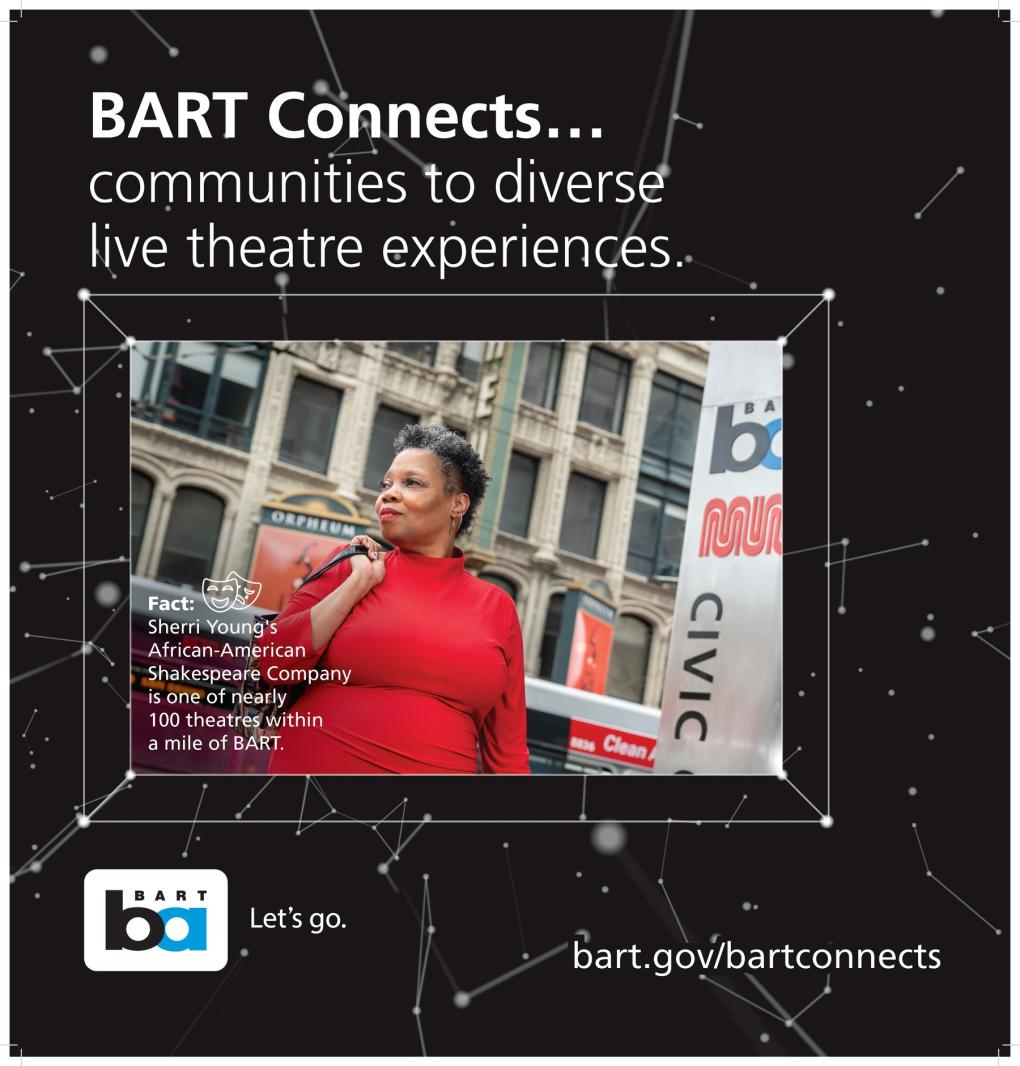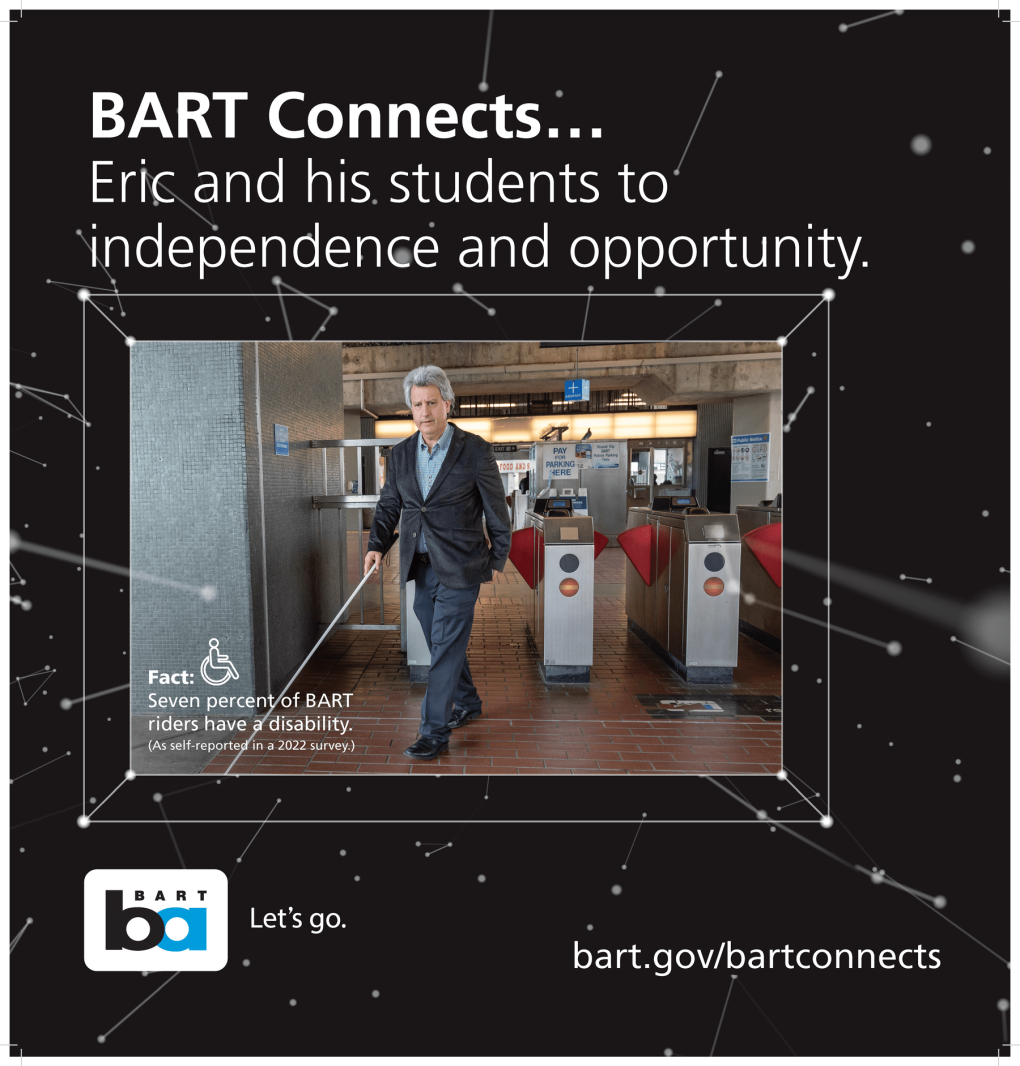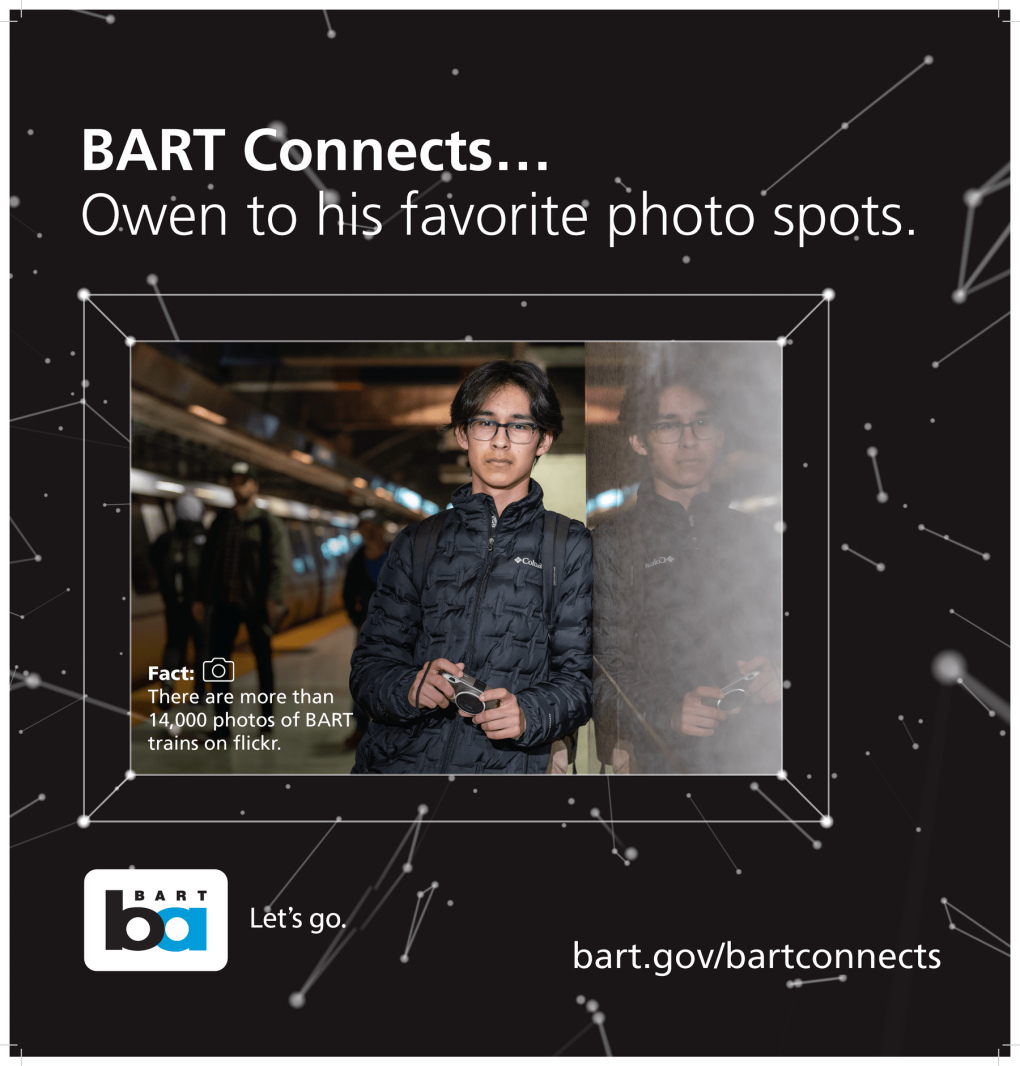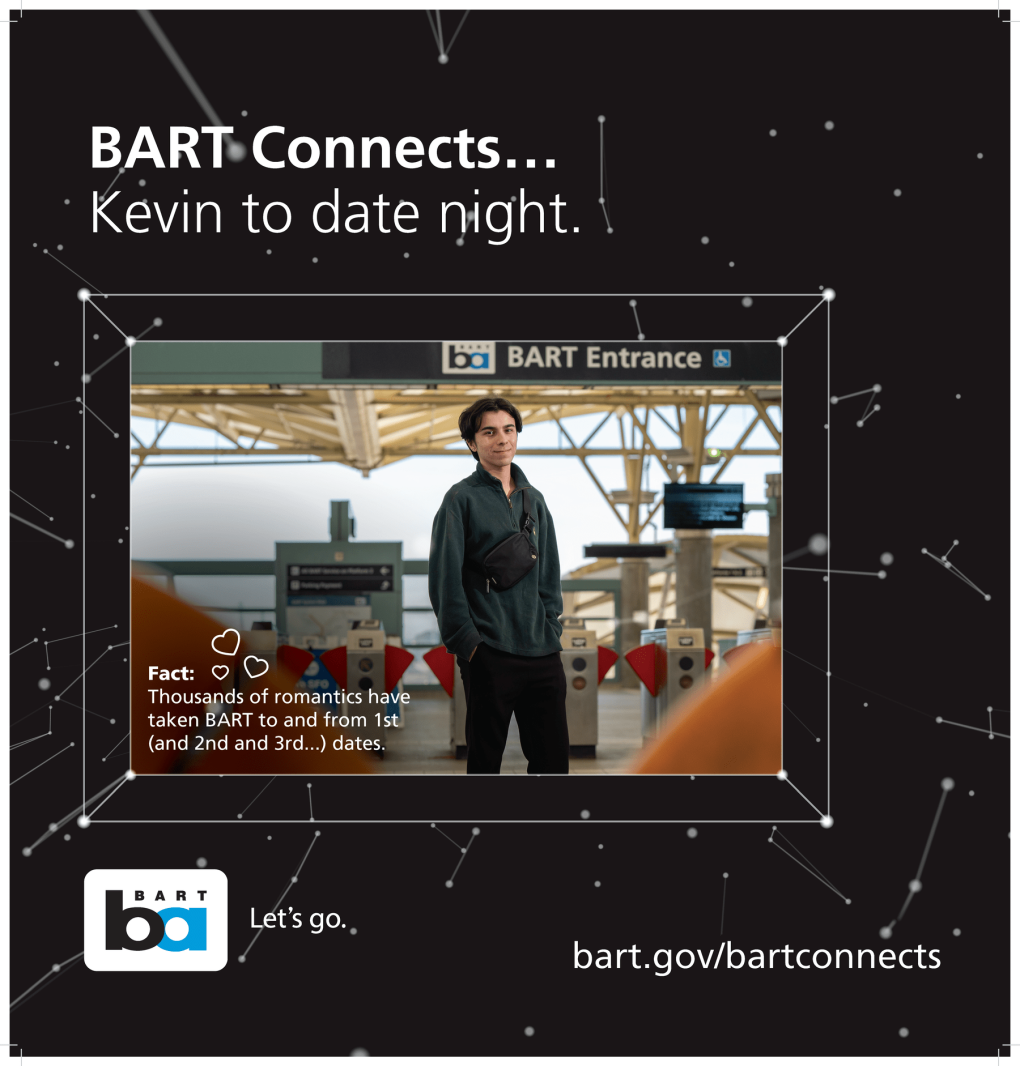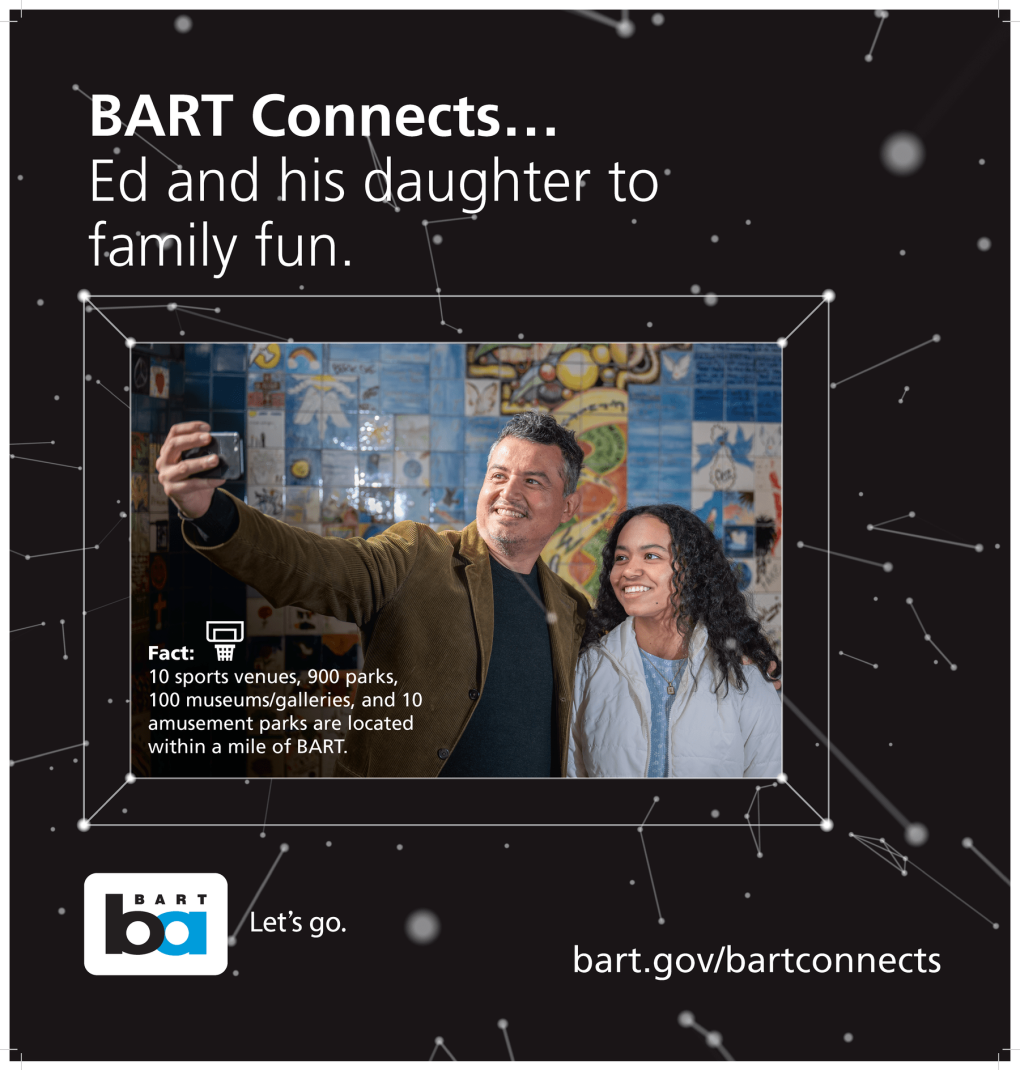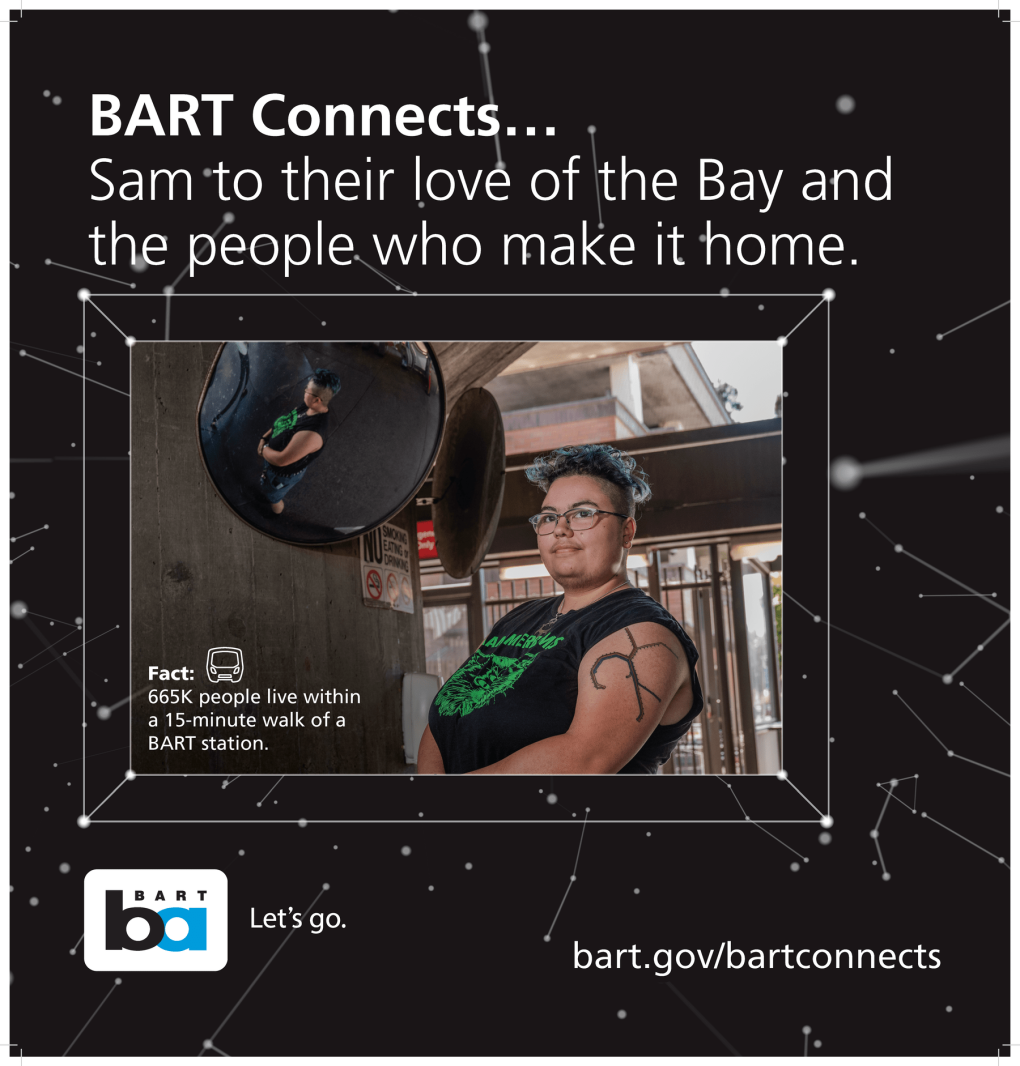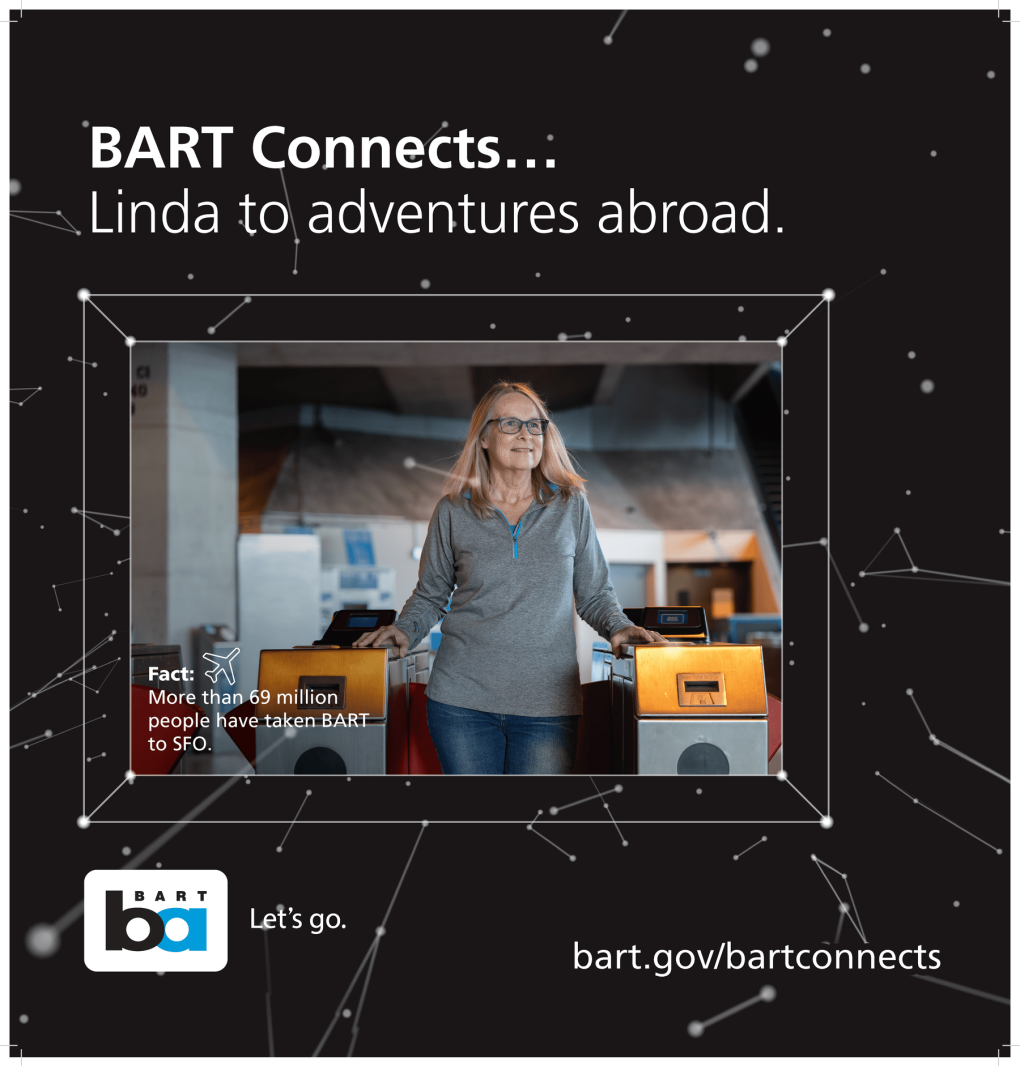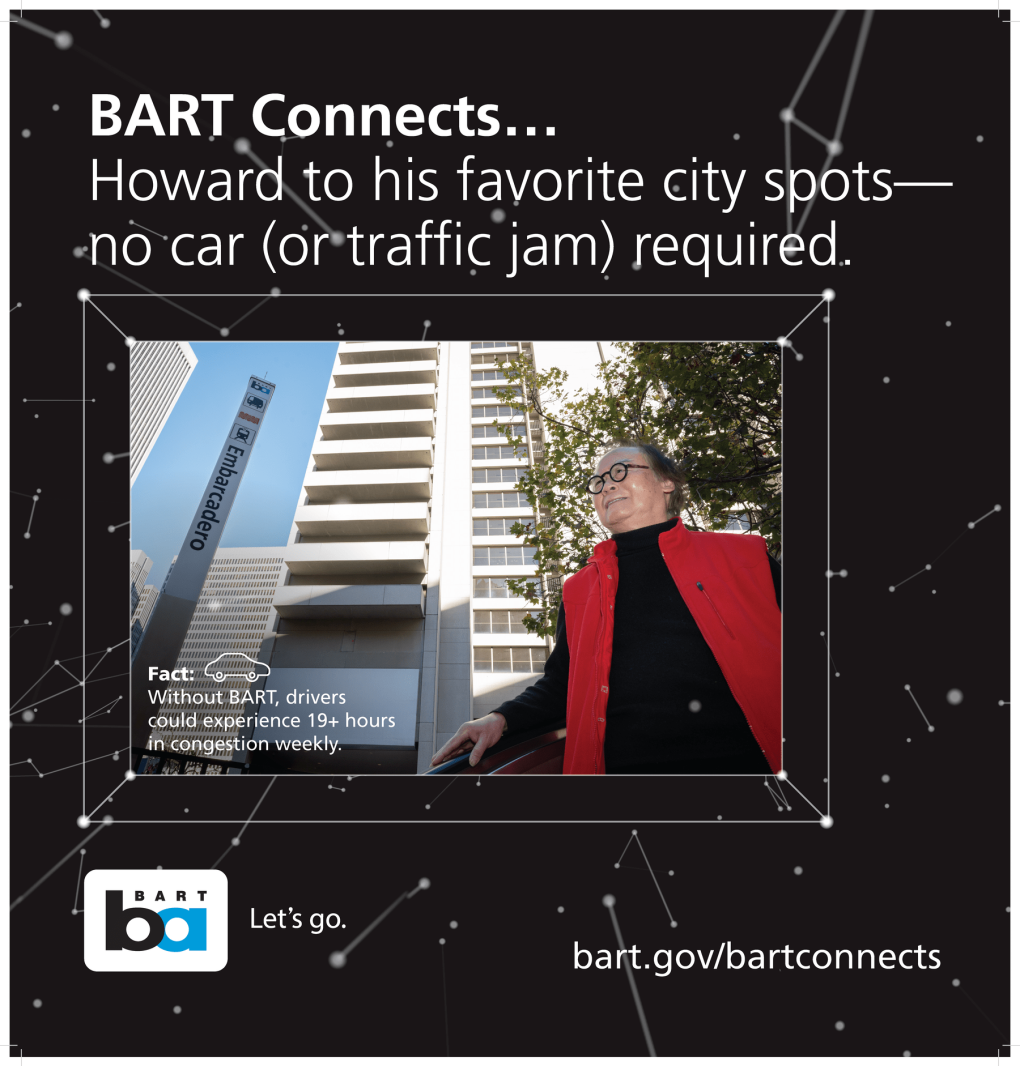About BART Connects
The BART Connects storytelling series was launched in 2023 to showcase the real people who ride and rely on BART and illustrate the manifold ways the system affects their lives. The subjects of BART Connects are featured in a marketing campaign currently running across the Bay Area.
The series grew out of BART's Role in the Region Study, which demonstrates BART’s importance to the Bay Area’s mobility, cultural diversity, environmental and economic sustainability. We conducted a call for stories to hear from our riders and understand what BART means to them. More than 300 riders responded, and a selection of respondents were interviewed for the BART Connects series.
Discover activities, events, restaurants, museums, and more by BART by visiting BARTable.
Do you have a favorite BART memory or story to share? Email a short summary to BART Storyteller Michelle Robertson at [email protected], and she may follow up to schedule an interview.
BART Connects: The Stories
Read the stories by clicking on the dropdowns below.
BART takes a second-year college student to her dream school
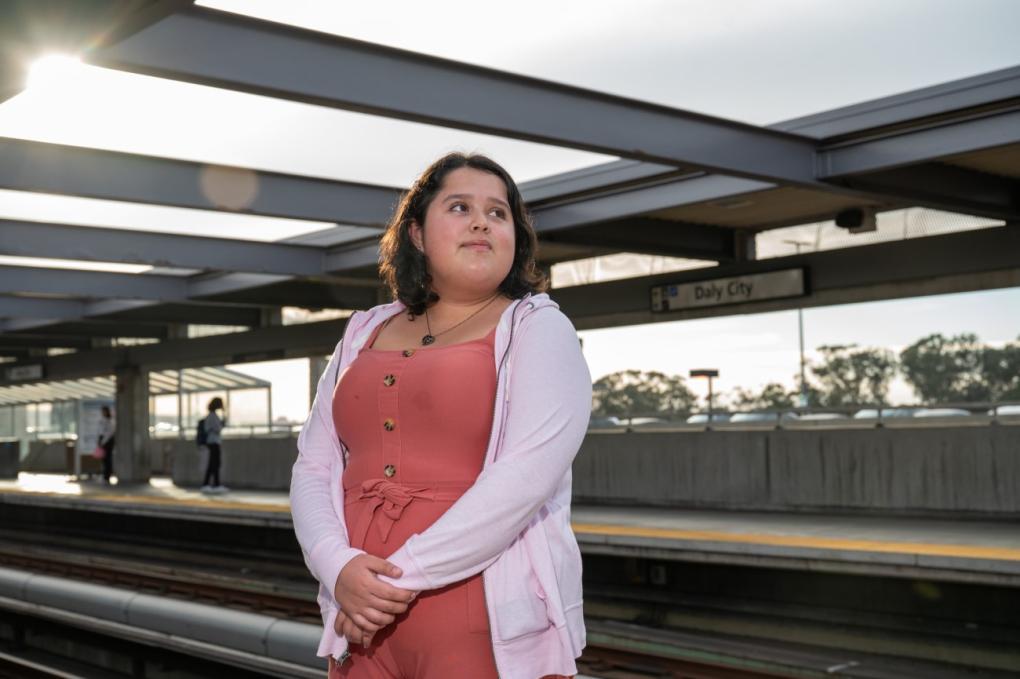
Read the Story
In August, Kassandra Santillan started her second year at San Francisco State University, her dream college where she studies microbiology, her dream major. If she couldn’t take BART to school, she wouldn’t be able to attend. “BART made it happen for me,” she said. “I can’t afford to live near campus, so I’d probably be at a community college instead.”
“It’s pretty crazy to be studying the field now,” she continued. “It feels unreal sometimes. I know a lot of people who don’t get this opportunity.” Sometimes, she has to remind herself: “I’m really here, and I’m really doing this thing I’ve been trying to do all my life.”
BART gave a civic architect “a sense of what was possible” for urban design

Read the Story
Howard Wong grew up riding public transportation around San Francisco. He remembers well when BART opened for service in 1972; the experience of riding the “Space Age” trains left a lasting impact on him. Around the time of the system’s opening, Wong was studying architecture and design at UC Berkeley. He said BART helped inform his “democratic sensibilities on urban design."
“No matter your class, you had a sense that you were getting special treatment when you rode the trains,” he said. “You really felt like you were a part of this democracy of benefits. You're sitting on a train with all the commuters who seemed much more affluent with their suits and ties and briefcases, but you’re right there on that train with them.”
A Bay Area dad uses BART to spend time with his teenaged daughter
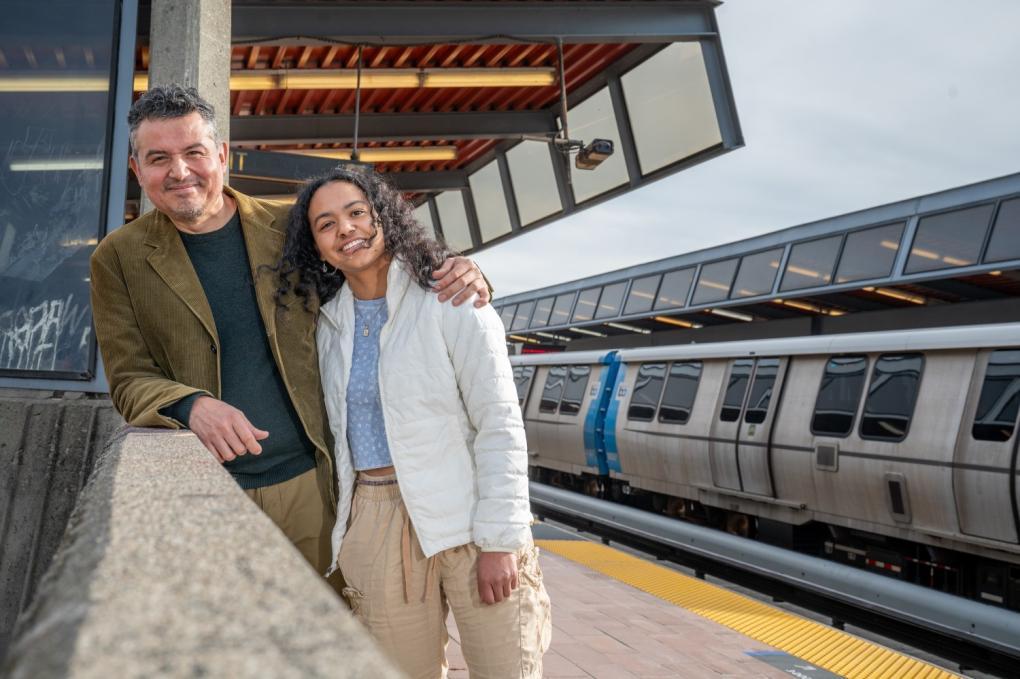
Read the Story
Ed Cabrera lives in Oakland, and he frequently travels into San Francisco to hang out with his teenaged daughter, Elyse, when she’s staying with her mom in San Francisco. Cabrera said he regularly uses BART "to facilitate spending time with my daughter and acclimate her to city living.” When Elyse was young, her parents mostly shuttled her by car to school, social activities, and extracurriculars.
But Cabrera wanted Elyse to feel comfortable navigating the city independently, so he made a point to “transition her out of the family car” and get her on public transportation to explore the neighborhoods beyond the one in which she lived. Soon, Elyse was taking BART and Muni to meet friends at Dolores Park, to hang around the Castro, and to play mini golf at the course in the Mission District. “It exposed her to different types of people,” Cabrera said. “What better place than BART to get to the know the people around you. It’s the great equalizer!”
Looking for fun activities to do with your kid by BART? Visit bart.gov/bartable to discover the Bay by BART, including free and fun activity roundups.
A high school for gifted neurodivergent youth relocated to be closer to BART

Read the Story
Orion Academy, a high school for gifted youth who are neurodivergent, relocated in 2022 to be closer to a BART station. More than half of the school’s students now take BART to school, which is located just a short walk from Concord Station. Being near BART makes the academy’s resources accessible to a broader community and teaches students how to independently navigate urban environments, where many will live and work after graduating. Orion Academy’s students sometimes have trouble with visual-spatial processing, and driving a car can be overwhelming. “So, what is your alternative? Taking public transportation!” said Dr. Kathryn Stewart, the founder and Executive Director of the academy.
BART is a local teen photographer's muse

Read the Story
Most people see BART as a means to an end, a space you pass through to get where you need to go. Owen Flaherty sees BART as a portal to a realm of creativity.
Flaherty is an avid photographer. A few years ago, when he was in eighth grade, he got his first camera – a Panasonic Lumix. Initially, he didn’t have the time nor motivation to get out into the world and start photographing. But in the summer after eighth grade, he found himself suddenly drawn to, and quickly absorbed into, the art form. He credits BART for giving him his first jolt of creative inspiration. In many ways, BART was his first muse, the Beatrice to his Dante.
“BART was exactly what I needed to get started with my photography,” he said. “The people, the movement, the lighting, the station design...BART has everything you need to create a great photograph.”
A transit wedding happened naturally for these newlyweds
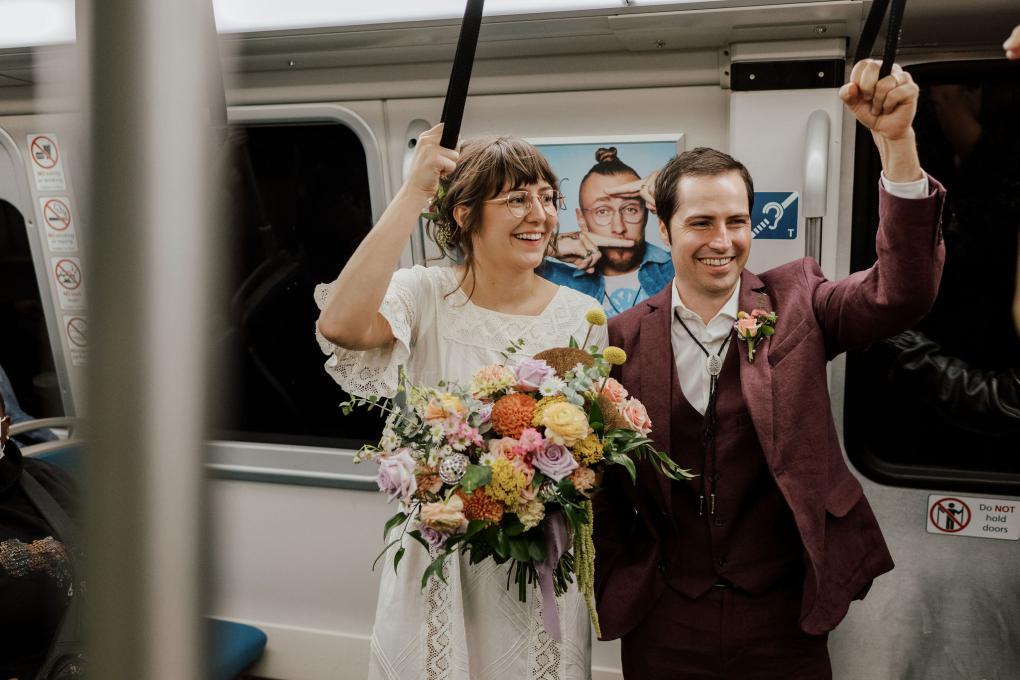
Read the Story
Mahalia LeClerc and Benjamin Frisbey never set out to have a transit wedding. It just kind of happened that way.
“We were never like, let’s make sure we include BART in the wedding,” said Mahalia. But when she and her now-husband picked the ceremony spot – San Francisco City Hall – and then the party venue – transit-themed Line 51 Brewing Company in Jack London Square – they needed a way to get themselves and their guests from the one place to the other. Public transit simply made sense.
“We value public transit,” Mahalia said. "And though we didn’t plan it that way, our experiences using it naturally led us to having a transit wedding.”
A young woman from East Oakland says she "wouldn't be where I am today" without BART
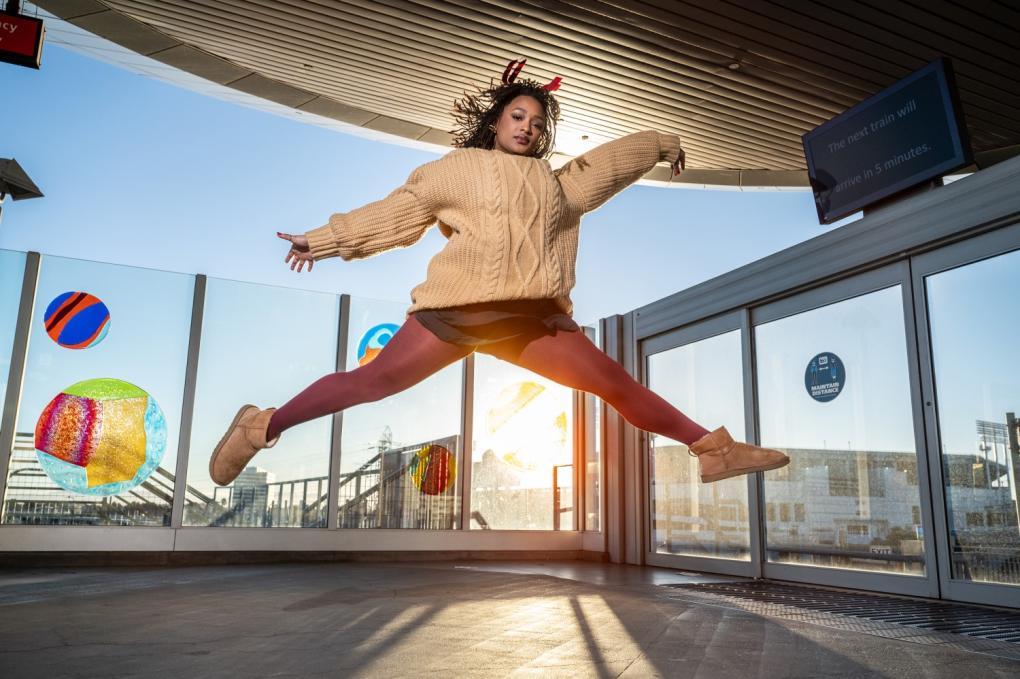
Read the Story
BART runs like a thread through every stage of Erica Mitchell’s existence. You might say the system map is a tapestry of her life, woven with memories that stretch from childhood to maturity.
Mitchell grew up in East Oakland near Coliseum Station. The trains that departed every which way from the station were “lifelines,” she said, that carried her to novel places, experiences, and possibilities.
“At different points in my life, BART has meant different things to me,” said Mitchell, now 27 and living in San Francisco. “I wouldn’t have been as independent as I was as a kid without BART; I wouldn’t have been able to survive here; and I wouldn’t be where I am today."
A working mom remembers when her only downtime each day was her BART ride
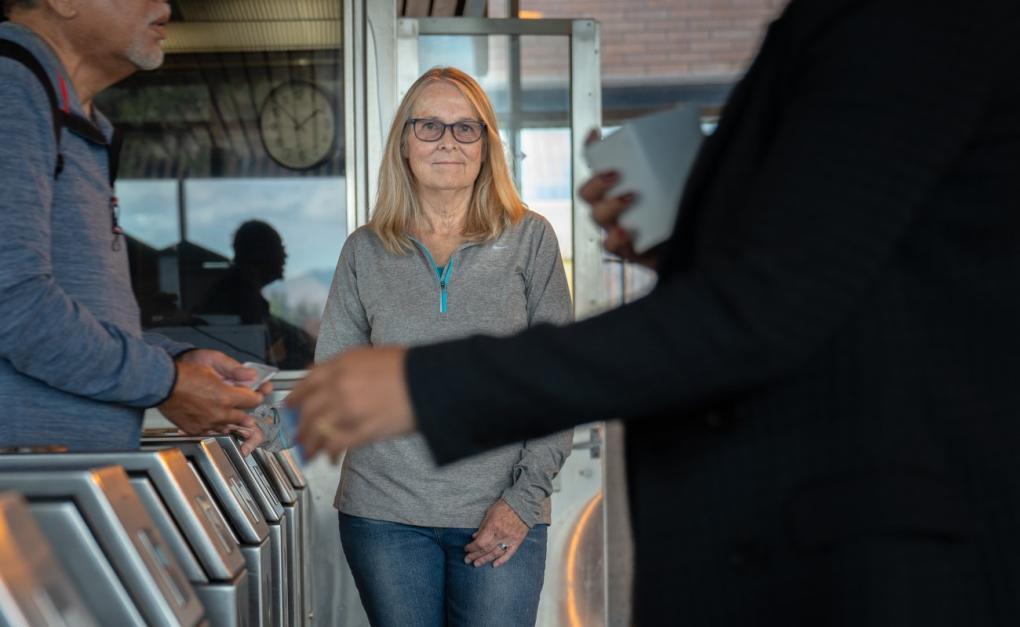
Read the Story
Linda Healey commuted to San Francisco from Walnut Creek for more than twenty years. When her son was young, those daily BART rides were her only downtime in the day. “BART got me home to my child quickly,” she said. “And it got me home unstressed because I could relax, rather than sit in traffic. That was a gift.” Today, Healey’s son – now in his thirties and living in Oakland – does the same commute his mother did for so many years, though he hops on the train a few stops up the line. He even works for the same company. “I passed the BART baton to him,” Healey said. “Hopefully one day, he’ll get to take it just for fun.”
After moving away from the Bay as a child, a young rider stayed connected to the region through BART

Read the Story
When Giovanna Lomanto was young, her family moved from Daly City to Sacramento. After the move, she always looked forward to her family’s trips back to the Bay. From Sacramento, Lomanto and her sister would drive with their grandparents to Pittsburg/Bay Point Station, where they’d catch a BART train to 12th Street/Oakland Station. Their destination was Oakland Chinatown, where Lomanto’s grandma and grandpa would visit their old church friends and the traditional Chinese medicine practitioners they'd been seeing for years. They’d take BART because it was fun – a remnant of a previous life – but mostly because parking was a hassle in Chinatown and free at the BART station on weekends.
“BART kept us connected to the Bay Area,” Lomanto said. “Especially the free weekend parking. That’s rare here!”
A new Bay Area resident's first glimpse of the U.S. was through the windows of a BART train
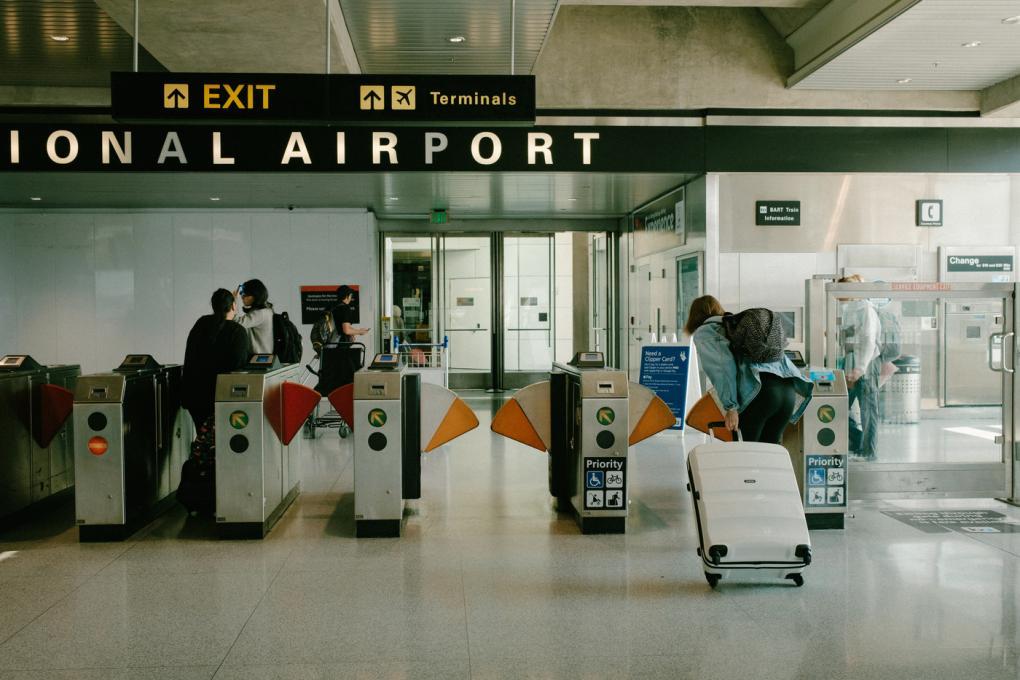
Read the Story
Katelyn Breaty and her family immigrated from the Philippines ten years ago. She got her first glimpse of the place she’d now call home from the windows of a Richmond-bound BART train. Breaty was six or seven at that time and hadn’t yet learned to speak English. Through her young eyes, the terminal at San Francisco International Airport was a mess of chaos and activity. “I had no idea what was going on. I just hopped on BART,” she said. “I’d never experienced anything like it.” Since their arrival in the U.S., Breaty’s family has lived in Martinez, Vallejo, Daly City, San Francisco, Hayward...the list goes on. Every time they moved, BART was a lifeline for Breaty, keeping her connected to the friends she left behind.
“BART was the driving force that helped me escape the suburbs, that made me feel free,” she said. “Having grown up poor, BART has been a getaway from my life that enables me to go somewhere fun, exciting, fulfilling."
Follow our guide to taking BART to SFO and OAK airports.
How BART's Small Business Support Services uplifts one trailblazing local business owner
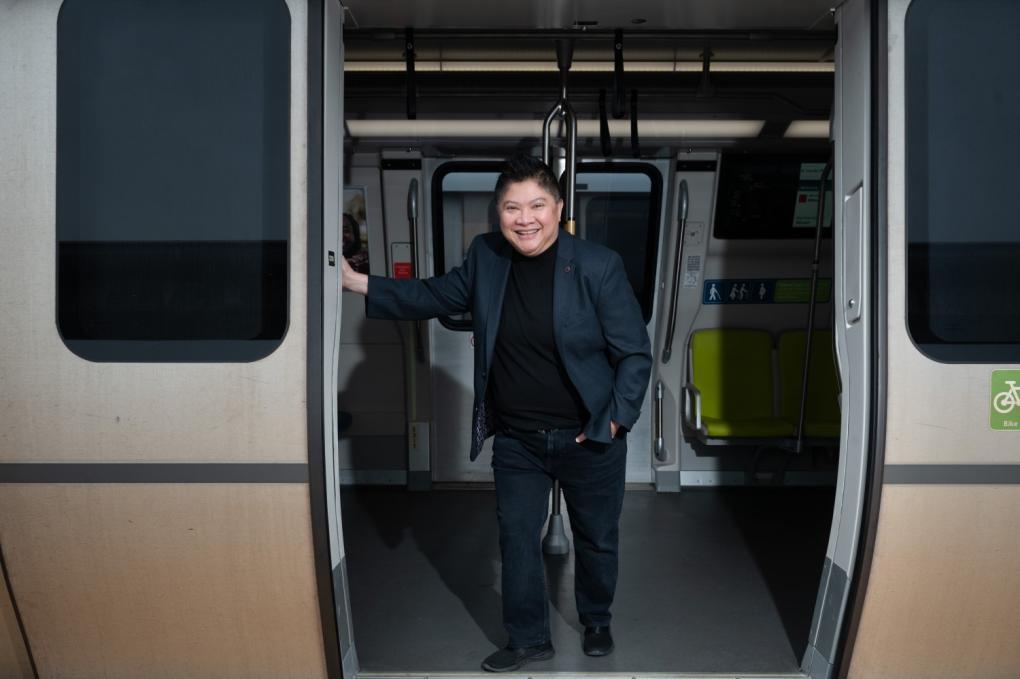
Read the Story
In the construction world, small business owner Sandra Escalante said she is often referred to as a “unicorn.”
“I’m a woman, a minority, and a member of the LGBT community,” she said recently. “It’s very difficult just to be an employee in the construction world. A business owner? Ha.”
Escalante owns Laner Electric Supply Company, a wholesale distributor of electrical and lighting tools and supplies headquartered in a 16,000-square-foot warehouse in Richmond, Calif. The company is one of 670 small businesses supported by BART’s Small Business Support Services (SBSS), a program operated by BART’s Office of Civil Rights.
"Programs like SBSS are the beginning of changing mindsets,” she said. “If you don’t change mindsets, nothing will change materially."
BART showed Steve and Vanessa that "there is life out there"
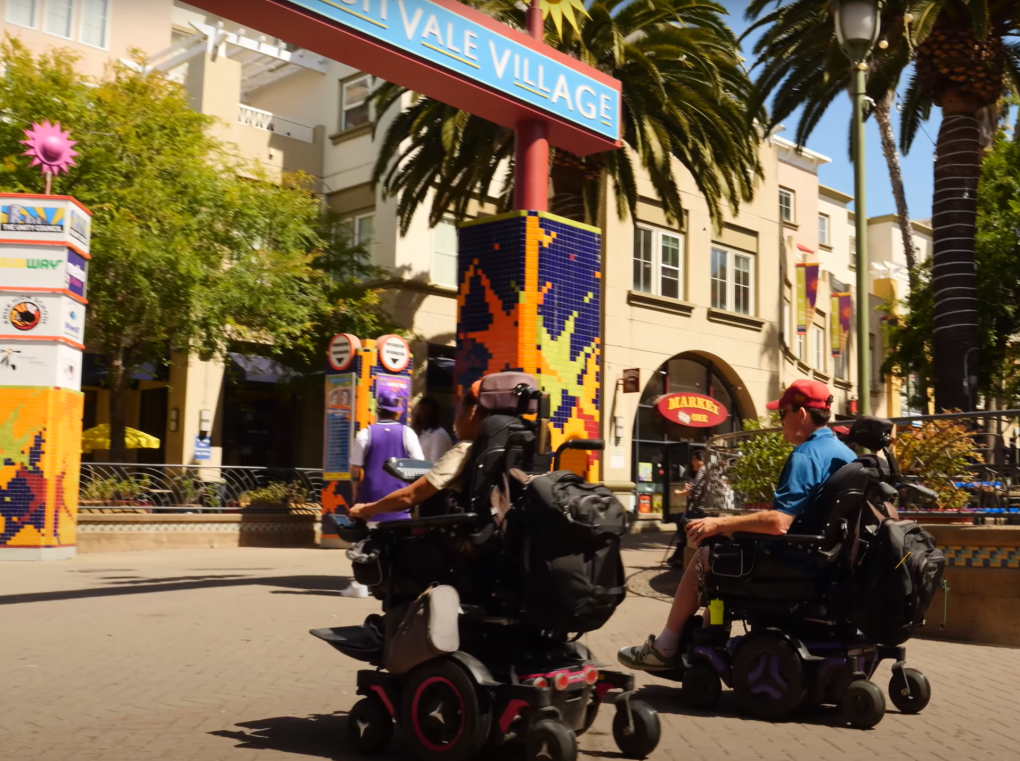
Read the Story
July 26, 2024, marks the 34th anniversary of the Americans with Disabilities Act (ADA), which was signed into law on July 26, 1990. The ADA protects the rights of those with disabilities and is recognized as a watershed milestone for civil rights in the U.S.
More than 7% of BART riders have a disability (as self-reported in a 2022 survey), including Steven Howell and Vanessa Castro. Steven and Vanessa use BART to get just about everywhere. Says Steven: "[BART] showed me there is life out there."
Hear more from the couple in our video on bart.gov/news.
A college student’s career ambitions – and romance – blossomed thanks to BART
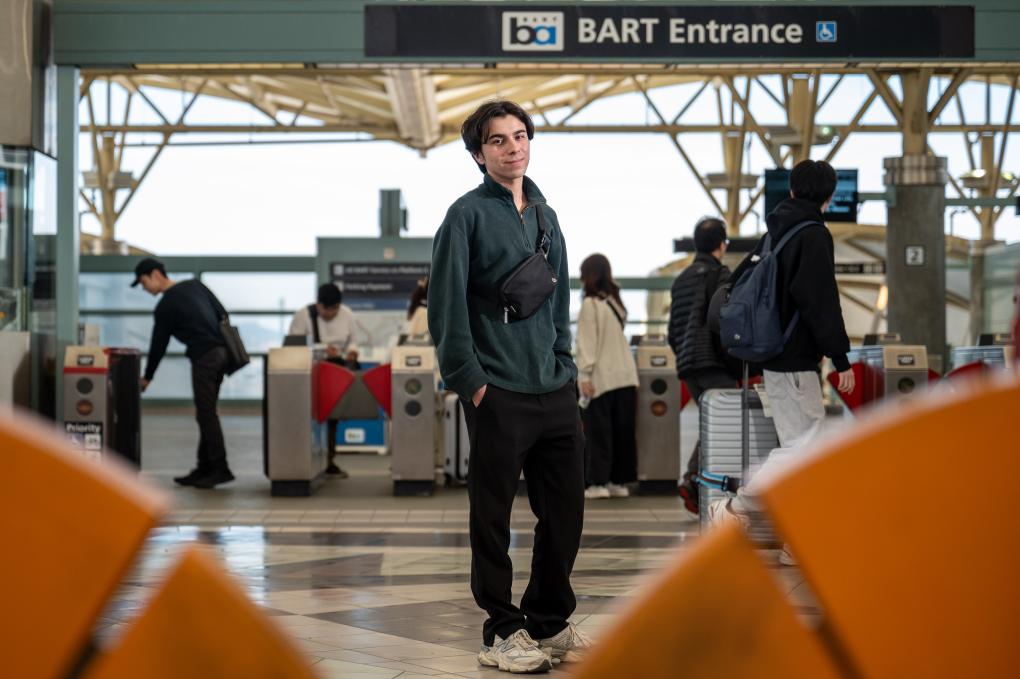
Read the Story
In just a year of riding BART, Kevin DeAntoni made a decision. When he graduates from San Francisco State in a few years, he’s going to be an urban planner specializing in transportation.
Though he grew up in the Bay Area, DeAntoni had never really used BART until 2023. He lives in Redwood City, which doesn't have a BART station, and his default mode of transportation had always been a car.
Then, DeAntoni met someone. The issue? His potential flame lived fifty miles away on the other side of the bay.
Then, he remembered Walnut Creek has a BART station, and that BART station happened to be just a short walk from his budding romantic partner's house. DeAntoni realized he could park at Millbrae Station then ride to Walnut Creek for under $8 one way -- a fare he could afford on his student budget. And so, he said to himself, "Why not? Let's try it."
BART has carried Elvis Herselvis to drag performances for 30 years
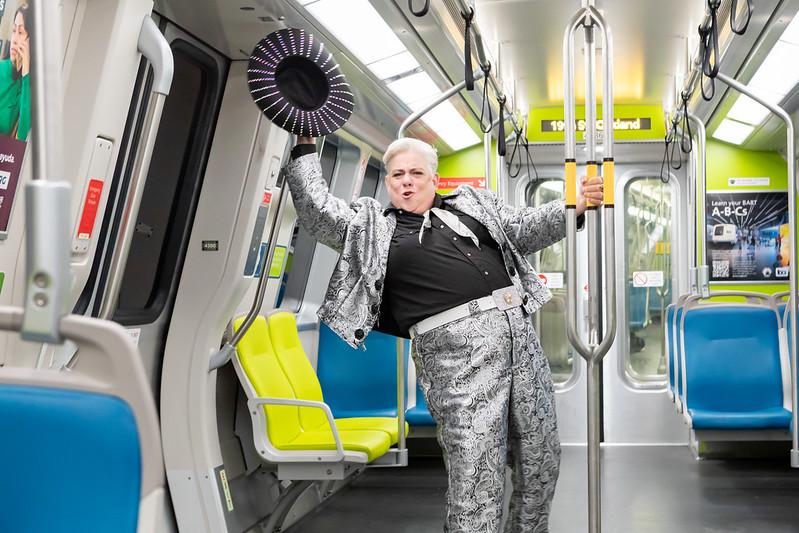
Read the Story
Elvis Presley loved his bubblegum pink Cadillac. Elvis Herselvis prefers a blue-and-white ride. Her vehicle is roomier than that Fleetwood Sixty Special, boasts twice as many wheels, and unlike that old gas guzzler, it runs on electricity.
We’ll toss her the mic so she can say it herselvis: “My life would suck without BART.”
For thirty years, Elvis Herselvis, the drag king persona of legendary drag performer, artist, and musician Leigh Crow, has taken BART to rehearsals, performances, bars, brunches, and her brother’s house in Richmond.
Unlike Mr. Presley, Crow doesn’t drive, so without BART she’s not totally sure what she’d do. Spend a lot on rideshares, probably, but that’s a cruddy option when you’re regularly traveling back and forth between San Francisco, where she typically performs, and Oakland, where she lives. About a decade ago, Crow moved to Oakland after being priced out of San Francisco. She came to the Bay Area from suburban Phoenix as a young lesbian looking for performing opportunities.
“Public transportation was one of the very attractive things about moving to San Francisco,” Crow said. “Where I grew up, you had to have a car. In the Bay, you can get where you need to go almost entirely on transit.”
Looking for fun activities by BART? Visit bart.gov/bartable to discover the Bay by BART, including music venues just a short walk from a station.
With $300 in her wallet and a dream, one BART track operator forged her own path
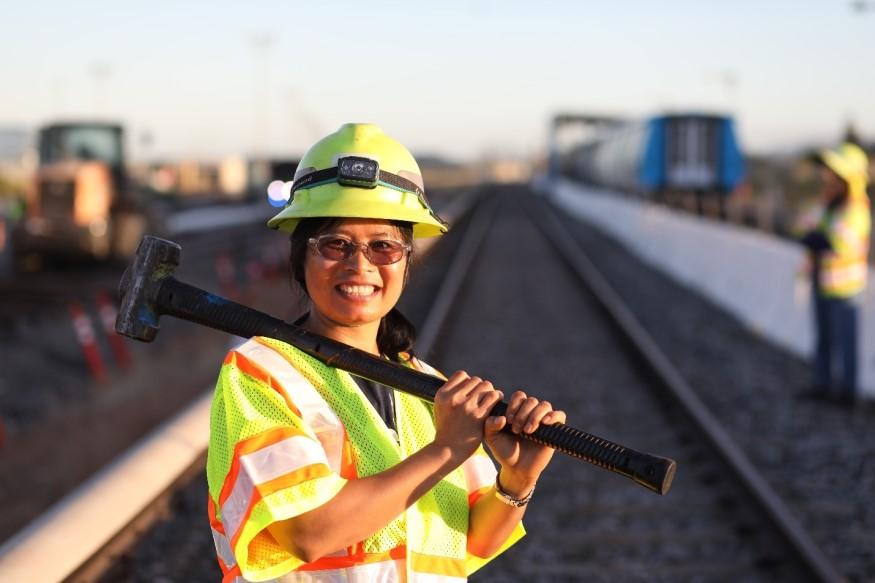
Read the Story
On a recent Saturday morning, Thu Nguyen made her way to the Hayward Maintenance Complex, where a dozen workers were busy uprooting old track and laying the groundwork for a new track switch under the morning sun.
When Nguyen arrived, the workers – all men – in their bright yellow safety vests and hard hats greeted her with exclamations and smiles.
“Hi, everyone!” said Nguyen, smiling back.
Nguyen has worked at BART as a track worker for two-and-a-half years. Recently, she was promoted to track operator, meaning “I have a little more responsibility,” she said.
Nguyen’s path to track operator was not an easy one. She grew up in rural Vietnam, where she worked in the fields of her family’s farm.
“From a young age, I did a lot of physical work. I learned [from the time I was a child] to do what is happening here,” she said, gesturing at the men working around her.
Learn more about job openings at BART at bart.gov/jobs.
Why Eric’s students at the Orientation Center for the Blind ‘fall in love’ with BART when they come to the Bay
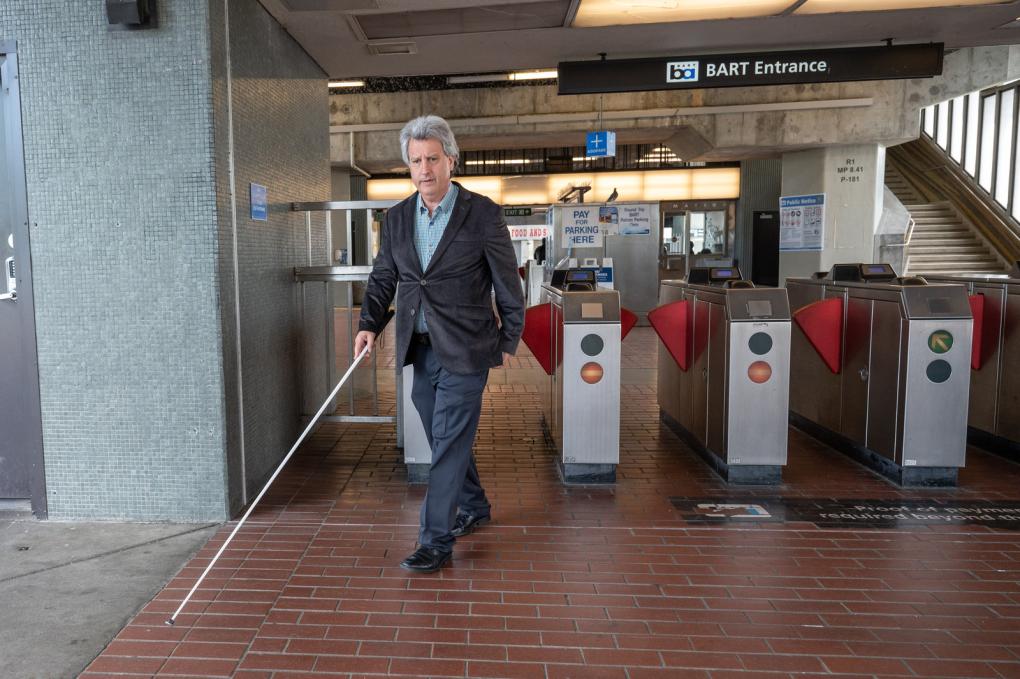
Read the Story
Eric Mazariegos has been taking BART “forever.”
His earliest BART memory is riding trains to eye doctor appointments in San Francisco with his mom. He was eight years old when he started losing his vision, and it took doctors two years to figure out what was happening. That meant lots of appointments – and lots of BART.
Those long BART rides from his home in Concord to San Francisco and back turned out to be a useful educational tool as his vision loss progressed.
“I rode it so much as a kid, I’d memorized a lot of the stations,” he said. “I had a head start [for navigating the system without vision].”
Later in life, he began taking BART regularly, first to get to class at San Francisco State, then a job in Fremont, and now to his current workplace, the Orientation Center for the Blind (OCB).
BART and the African-American Shakespeare Company “help each other grow and succeed”
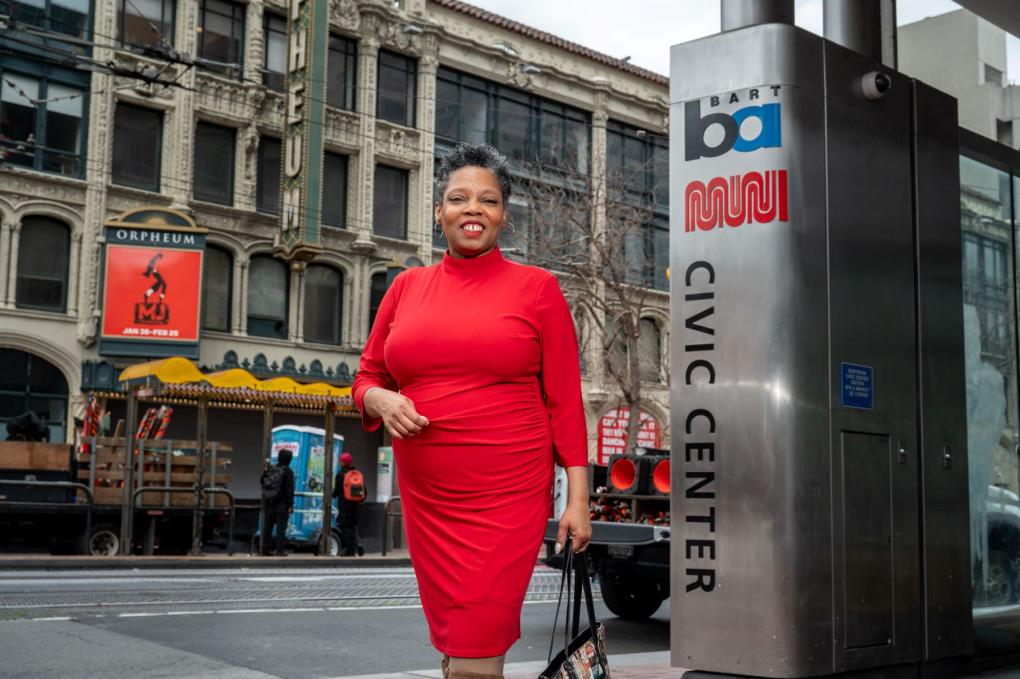
Read the Story
Lifelong BART rider Sherri Young took a major gamble in 2015 when she transferred the African-American Shakespeare Company from a 200-seat theater about a mile from BART to a series of big venues in Downtown San Francisco.
The performance spaces she chose – the Herbst Theatre, Taube Wilsey Atrium, and Marines Memorial Theatre – are nestled in the heart of the city’s vibrant theater and arts district encompassing parts of Union Square, the Tenderloin, and Civic Center. The area is home to iconic venues like the War Memorial Opera House, the Orpheum Theatre, the American Conservatory Theater, and the Orpheum, among many others. All of these historic theaters are a short walk from BART or, in the case of the Orpheum, just steps from the station.
Weighing the pros and cons of moving her company, Sherri calculated if people could take transit to the company’s performances, she just might be able to fill all the seats in those giant theaters.
“You have to meet the community where they are,” Sherri said. And if community members don't live near Downtown San Francisco, they most likely lived by BART or agencies that connect to it. You can’t go to the theater, she thought, if you don’t have a means to get there.
Looking for fun activities by BART? Visit bart.gov/bartable to discover the Bay by BART, including local theater venues like the African-American Shakespeare Company.
Sam uses their BART System Map tattoo to give directions
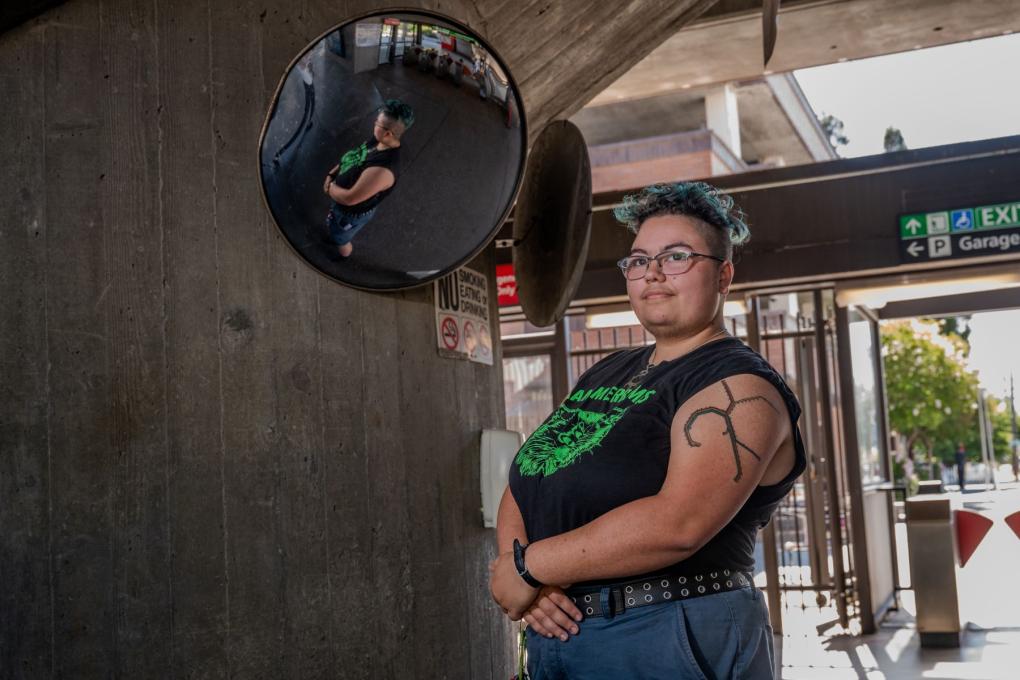
Read the story
When Sam Johnson sees someone lost in a BART station, they roll up their sleeve and show them a bicep.
Etched five layers deep into the epidermis of Sam’s right arm is a tattoo of the BART System Map. It’s Sam’s first and only tattoo, and in a pinch, it comes in handy.
“I’ve helped a bunch of people figure out where to go,” Sam said. “I point to my arm and say, ‘We’re here in Concord, you’re going to transfer to this station, then ride along here, and get off at this station.’”
It’s a practical tattoo but also a piece of art, an homage to the Bay, a love letter to transit. And let’s be honest, said Sam, “It looks good on me.”
BART Connects: The Advertisements
The riders of BART Connects are featured in a new advertising campaign that is posted on trains throughout the system. View the campaign art in the slideshow below.
